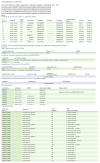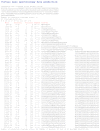Matrix metalloproteinases - From the cleavage data to the prediction tools and beyond
- PMID: 28347746
- PMCID: PMC5831720
- DOI: 10.1016/j.bbamcr.2017.03.010
Matrix metalloproteinases - From the cleavage data to the prediction tools and beyond
Abstract
Understanding the physiological role of any protease requires identification of both its cleavage substrates and their relative cleavage efficacy as compared with other substrates and other proteinases. Our review manuscript is focused on the cleavage preferences of the individual matrix metalloproteinases (MMPs) and the cleavage similarity and distinction that exist in the human MMP family. The recent in-depth analysis of MMPs by us and many others greatly increased knowledge of the MMP biology and structural-functional relationships among this protease family members. A better knowledge of cleavage preferences of MMPs has led us to the development of the prediction tools that are now capable of the high throughput reliable prediction and ranking the MMP cleavage sites in the peptide sequences in silico. Our software unifies and consolidates volumes of the pre-existing data. Now this prediction-ranking in silico tool is ready to be used by others. The software we developed may facilitate both the identification of the novel proteolytic regulatory pathways and the discovery of the previously uncharacterized substrates of the individual MMPs. Because now the MMP research may be based on the mathematical probability parameters rather than on either random luck or common sense alone, the researchers armed with this novel in silico tool will be better equipped to fine-tune or, at least, to sharply focus their wet chemistry experiments. This article is part of a Special Issue entitled: Matrix Metalloproteinases edited by Rafael Fridman.
Keywords: CleavPredict; MMPs; cleavage prediction tools; matrix metalloproteinases; software; substrate cleavage; substrate phage display.
Copyright © 2017. Published by Elsevier B.V.
Figures




Similar articles
-
CleavPredict: A Platform for Reasoning about Matrix Metalloproteinases Proteolytic Events.PLoS One. 2015 May 21;10(5):e0127877. doi: 10.1371/journal.pone.0127877. eCollection 2015. PLoS One. 2015. PMID: 25996941 Free PMC article.
-
Next generation matrix metalloproteinase inhibitors - Novel strategies bring new prospects.Biochim Biophys Acta Mol Cell Res. 2017 Nov;1864(11 Pt A):1927-1939. doi: 10.1016/j.bbamcr.2017.06.009. Epub 2017 Jun 19. Biochim Biophys Acta Mol Cell Res. 2017. PMID: 28636874 Review.
-
Basis for substrate recognition and distinction by matrix metalloproteinases.Proc Natl Acad Sci U S A. 2014 Oct 7;111(40):E4148-55. doi: 10.1073/pnas.1406134111. Epub 2014 Sep 22. Proc Natl Acad Sci U S A. 2014. PMID: 25246591 Free PMC article.
-
Family-wide characterization of matrix metalloproteinases from Arabidopsis thaliana reveals their distinct proteolytic activity and cleavage site specificity.Biochem J. 2014 Jan 15;457(2):335-46. doi: 10.1042/BJ20130196. Biochem J. 2014. PMID: 24156403
-
Matrix metalloproteinases as regulators of inflammatory processes.Biochim Biophys Acta Mol Cell Res. 2017 Nov;1864(11 Pt A):2036-2042. doi: 10.1016/j.bbamcr.2017.05.010. Epub 2017 May 11. Biochim Biophys Acta Mol Cell Res. 2017. PMID: 28502592 Review.
Cited by
-
Combinatorial engineering of N-TIMP2 variants that selectively inhibit MMP9 and MMP14 function in the cell.Oncotarget. 2018 Aug 10;9(62):32036-32053. doi: 10.18632/oncotarget.25885. eCollection 2018 Aug 10. Oncotarget. 2018. PMID: 30174795 Free PMC article.
-
Adaptive F-Actin Polymerization and Localized ATP Production Drive Basement Membrane Invasion in the Absence of MMPs.Dev Cell. 2019 Feb 11;48(3):313-328.e8. doi: 10.1016/j.devcel.2018.12.018. Epub 2019 Jan 24. Dev Cell. 2019. PMID: 30686527 Free PMC article.
-
Identifying specific matrix metalloproteinase-2-inhibiting peptides through phage display-based subtractive screening.Turk J Biol. 2021 Dec 14;45(6):674-682. doi: 10.3906/biy-2105-6. eCollection 2021. Turk J Biol. 2021. PMID: 35068948 Free PMC article.
-
XTX101, a tumor-activated, Fc-enhanced anti-CTLA-4 monoclonal antibody, demonstrates tumor-growth inhibition and tumor-selective pharmacodynamics in mouse models of cancer.J Immunother Cancer. 2023 Dec 12;11(12):e007785. doi: 10.1136/jitc-2023-007785. J Immunother Cancer. 2023. PMID: 38164757 Free PMC article.
-
Interactions between astrocytes and extracellular matrix structures contribute to neuroinflammation-associated epilepsy pathology.Front Mol Med. 2023 Jun 14;3:1198021. doi: 10.3389/fmmed.2023.1198021. eCollection 2023. Front Mol Med. 2023. PMID: 39086689 Free PMC article. Review.
References
-
- Maskos K. Crystal structures of MMPs in complex with physiological and pharmacological inhibitors. Biochimie. 2005;87:249–263. - PubMed
-
- Zucker S, Cao J, Chen WT. Critical appraisal of the use of matrix metalloproteinase inhibitors in cancer treatment. Oncogene. 2000;19:6642–6650. - PubMed
-
- Kukreja M, Shiryaev SA, Cieplak P, Muranaka N, Routenberg DA, Chernov AV, Kumar S, Remacle AG, Smith JW, Kozlov IA, Strongin AY. High-Throughput Multiplexed Peptide-Centric Profiling Illustrates Both Substrate Cleavage Redundancy and Specificity in the MMP Family. Chem Biol. 2015;22:1122–1133. - PMC - PubMed
Publication types
MeSH terms
Substances
Grants and funding
LinkOut - more resources
Full Text Sources
Other Literature Sources
Molecular Biology Databases

